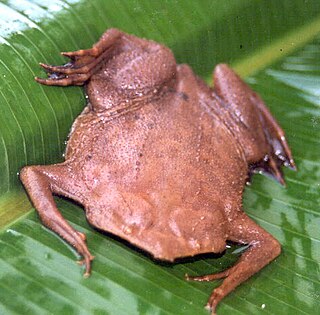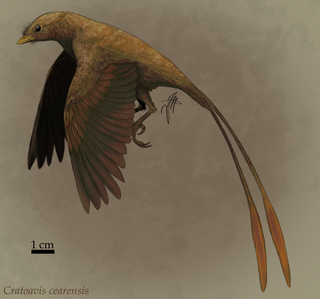Related Research Articles

The Crato Formation is a geologic formation of Early Cretaceous (Aptian) age in northeastern Brazil's Araripe Basin. It is an important Lagerstätte for palaeontologists. The strata were laid down mostly during the Aptian age, about 113 million years ago. It thought to have been deposited in a semi-arid lacustrine wetland environment.

The Pipidae are a family of primitive, tongueless frogs. There are 41 species in the family, found in tropical South America and sub-Saharan Africa.

Araripemys is an extinct marine turtle genus from 112 to 109 million years ago, in the Early Cretaceous Crato and Romualdo Formations of the Araripe Basin in northeastern Brazil. It is one of the oldest known pleurodires.

Palaeobatrachus is an extinct genus of frogs from Europe that existed from the middle Eocene to the middle Pleistocene, spanning almost 50 million years. They were obligately aquatic, and would have not spent much time on dry land. They are one of two genera and by far the largest genus in the family Palaeobatrachidae, which are considered to be members of Pipimorpha, related to the South American-African family Pipidae, which includes the African clawed frog and Surinam toad.
Arthurdactylus is a genus of pterodactyloid pterosaur from the Early Cretaceous Crato Formation of northeastern Brazil. It was a medium-sized pterosaur, with a wingspan of 4.5–4.6 metres (14.8–15.1 ft) and body mass of 15 kg (33 lb).
Brasileodactylus a genus of pterosaur from the Aptian-age lower Santana formation of Chapada do Araripe, Ceará, Brazil.

Cearachelys is an extinct genus of pleurodiran turtle which existed some 110 million years ago. The genus is monotypic, with only type species Cearachelys placidoi known.

Paleontology or palaeontology is the study of prehistoric life forms on Earth through the examination of plant and animal fossils. This includes the study of body fossils, tracks (ichnites), burrows, cast-off parts, fossilised feces (coprolites), palynomorphs and chemical residues. Because humans have encountered fossils for millennia, paleontology has a long history both before and after becoming formalized as a science. This article records significant discoveries and events related to paleontology that occurred or were published in the year 2009.
Baurubatrachus is an extinct genus of prehistoric frogs found in the Maastrichtian Marília Formation of Brazil, formerly considered to be related to the extant family Ceratophryidae. However, a detailed assessment of the anatomy and relationships of the single known fossil of Baurubatrachus demonstrated that it is not part of Ceratophryidae and might be part of a much ancient group of Neobatrachia.

Eodiscoglossus is an extinct genus of prehistoric frogs. It is known from the type species E. santonjae from the Early Cretaceous (Barremian) El Castellar Formation of Spain, as well as a referred species E. oxoniensis known from the Forest Marble Formation of the UK and an indeterminate species from the Dzunbain Formation of Mongolia. It was a small primitive frog, with a length of only 27 mm (1.1 in) from the premaxilla to the ischium. Formerly considered to be closely related to discoglossids, E. santonjae is now regarded as close to the root of the crown group of modern frogs in a position more derived than New Zealand frogs and tailed frogs, but more basal than costatans like alytids and other more advanced frogs like neobatrachians. The morphology of E. santonjae suggests a generalist and unspecialised movement habit. The referral of E. oxoniensis to Eodiscoglossus has been questioned, as it is much earlier than the type species and it is based on homoplasic and plesiomorphic characteristics inherited from a common ancestor, so there is no clear evidence of a close relation.
Wealdenbatrachus is an extinct genus of prehistoric frog known from the Lower Cretaceous of Uña, Spain, which is part of the La Huérguina Formation Its anatomy and relationships have recently been revisited, finding that this frog might be a proficient jumper, and that it was a primitive frog close to the ancestry of all modern frogs.

Araripichthys is an extinct genus of marine ray-finned fish that lived from the Aptian to Coniacian stages of the Cretaceous period. The genus is named after the Araripe Basin, where it was found in the Crato and Santana Formations. Other fossils of the genus have been found at Goulmima in Morocco, the Tlayua Formation of Mexico and the Apón Formation of Venezuela.

Pipoidea are a clade of frogs, that contains the most recent common ancestor of living Pipidae and Rhinophrynidae as well as all its descendants. It is broadly equivalent to Xenoanura.
Cratia is an extinct frog which existed in Brazil during the Early Cretaceous (Aptian). Fossils were discovered in and named after the Crato Formation. It was named by Ana M. Báez, Geraldo J.B. Moura and Raúl O. Gómez in 2009, and the type species is Cratia gracilis.

Susisuchus is an extinct genus of neosuchian mesoeucrocodylian crocodyliform from the Early Cretaceous of Brazil. Fossils have been found from the Nova Olinda Member of the Aptian-age Crato Formation in the Araripe and Lima Campos Basins of northeastern Brazil. Named in 2003, Susisuchus is the sole member of the family Susisuchidae, and is closely related to the clade Eusuchia, which includes living crocodilians. The type species is S. anatoceps, known from a single partial articulated skeleton that preserves some soft tissue. A second species, S. jaguaribensis, was named in 2009 from fragmentary remains.

The Araripe Basin is a rift basin covering about 8,000 square kilometres (3,100 sq mi), in Ceará, Piauí and Pernambuco states of northeastern Brazil. It is bounded by the Patos and Pernambuco lineaments, and is situated east of the Parnaíba Basin, southwest of the Rio do Peixe Basin and northwest of the Tucano and Jatobá Basins.

Cratoavis is a genus of enantiornithines. The type and only currently described species is C. cearensis, from the Early Cretaceous of Araripe Basin, Ceará, Brazil. The fossil, an articulated skeleton with feathers attached to the wings and surrounding the body, extends considerably the temporal record of the group at South America.

The Santana Group is a geologic group, formerly included as the middle part of the Araripe Group, in the Araripe Basin of northeastern Brazil. The group comprises the Crato, Ipubi and Romualdo Formations and is dated to the Aptian to Albian stages of the Early Cretaceous. The formations of the group were deposited in a lacustrine to subtidal shallow marine environment in the Araripe rift basin.
The Malhada Vermelha Formation is an Early Cretaceous geologic formation in Ceará, northeastern Brazil. The formation preserves reptile, fish and ichnofossils.

Araripelepidotes is a genus of ginglymodian fish.
References
- 1 2 3 Ana M. Báez; Geraldo J.B. Moura & Raúl O. Gómez (2009). "Anurans from the Lower Cretaceous Crato Formation of northeastern Brazil: implications for the early divergence of neobatrachians". Cretaceous Research. 30 (4): 829–846. Bibcode:2009CrRes..30..829B. doi:10.1016/j.cretres.2009.01.002.
- 1 2 "Barbalha (Cretaceous of Brazil)". PaleoBiology Database. Retrieved 29 April 2022.